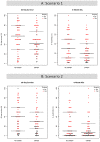Surgical decision making in the setting of severe traumatic brain injury: A survey of neurosurgeons
- PMID: 32119677
- PMCID: PMC7051065
- DOI: 10.1371/journal.pone.0228947
Surgical decision making in the setting of severe traumatic brain injury: A survey of neurosurgeons
Abstract
Background: Surgical decision-making in severe traumatic brain injury (TBI) is complex. Neurosurgeons weigh risks and benefits of interventions that have the potential to both maximize the chance of recovery and prolong suffering. Inaccurate prognostication can lead to over- or under-estimation of outcomes and influence treatment recommendations.
Objective: To evaluate the impact of evidence-based risk estimates on neurosurgeon treatment recommendations and prognostic beliefs in severe TBI.
Methods: In a survey-based randomized experiment, a total of 139 neurosurgeons were presented with two hypothetical patient with severe TBI and subdural hematoma; the intervention group received additional evidence-based risk estimates for each patient. The main outcome was neurosurgeon treatment recommendation of non-surgical management. Secondary outcomes included prediction of functional recovery at six months.
Results: In the first patient scenario, 22% of neurosurgeons recommended non-surgical management and provision of evidence-based risk estimates increased the propensity to recommend non-surgical treatment (odds ratio [OR]: 2.81, 95% CI: 1.21-6.98; p = 0.02). Neurosurgeon prognostic beliefs of 6-month functional recovery were variable in both control (median 20%, IQR: 10%-40%) and intervention (30% IQR: 10%-50%) groups and neurosurgeons were less likely to recommend non-surgical management when they believed prognosis was favorable (odds ratio [OR] per percentage point increase in 6-month functional recovery: 0.97, 95% confidence interval [CI]: 0.95-0.99). The results for the second patient scenario were qualitatively similar.
Conclusions: Our findings show that the provision of evidence-based risk predictions can influence neurosurgeon treatment recommendations and prognostication, but the effect is modest and there remains large variability in neurosurgeon prognostication.
Conflict of interest statement
The authors have declared that no competing interests exist.
Figures


References
-
- Finkelstein EA, C. P., Miller TR, The Incidence and Economic Burden of Injuries in the United States. Journal of Epidemiology Community Health, 2007. 61(10): p. 926.
MeSH terms
LinkOut - more resources
Full Text Sources
Medical

